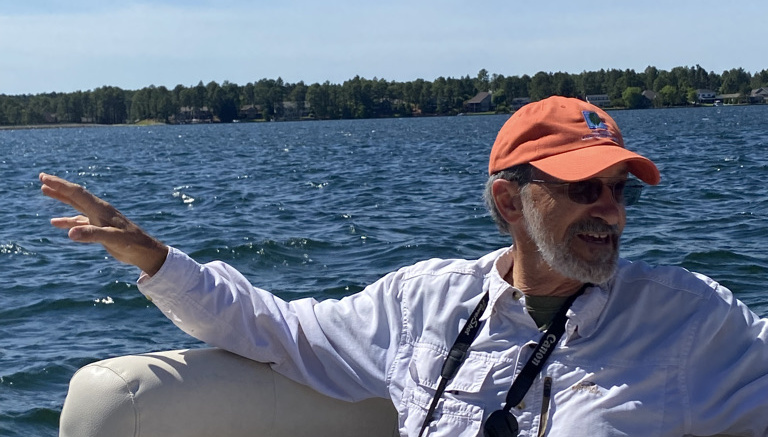BY MAGGIE BEAMGUARD, Insider Editor
Joe Easley, chairperson of the Seven Lakes West Architectural Review Committee, had turtles on his mind.
At an ARC meeting earlier this year, he wondered about how turtle nesting habits might be affected by lakefront property development and the installation of bulkheads.
ARC member Debbie Fox agreed to look for some answers on the committee’s behalf. She started her research by contacting surrounding HOAs, only to find out they were the first to explore the issue. Then she turned to Google.
Her search eventually brought her to one of North Carolina’s treasures, renowned herpetologist Alan Braswell.
With degrees in wildlife biology, botany and zoology from N.C. State University and 40 years of experience in various curatorial roles with the N.C. State Museum of Natural Sciences, the recipient of the Longleaf Pine seemed like just the man to answer Fox’s questions about reptiles.
Now retired, Braswell volunteered to come down to Lake Auman to observe and assess the lakefront for turtle accessibility and to address the community.
On May 10, Fox and Braswell set off on a shoreline tour with Lake Auman Auman Sports Club representative Stan Makson at the helm.
Fox estimates that about 90 percent of lakefront properties have bulkheads. Bulkheads are challenging for turtles. They create a level edge out to the water that the boxy, short-legged animals can’t vertically traverse.
“Well, they can get back in,” Braswell said, “they just have to walk to the edge and plop over. They just can’t climb up one.”
As Braswell observed the lake properties, he looked out for undeveloped land around the lake’s edge and beach areas, all of which are turtle friendly. Those areas provide pathways which likely attract a fair amount of turtle nesting.
Even though it was a cold, windy day, there were many turtles out sunning. Basking platforms provide the turtles a space to enjoy and humans a chance to enjoy the turtles. But to encourage nesting, the turtles need direct land access. Braswell spied mostly yellow-bellied sliders on the day he visited.

Braswell’s talk at the Community Center later that evening was attended by about 40 people, with another dozen or so watching online. After a review of the most common species likely to be found in the area, he shared his observations from the survey of the lake.
“I was a little afraid I wasn’t going to see much,” Braswell said. “But I saw enough areas. Turtles will learn where those areas are so they can get out. And I think you’ve got enough areas that they can get out to nest.”
Turtles will return to spots they like year after year, nesting within 100 yards of water, though they sometimes travel up to a quarter mile. They look for a spot that receives about 50-60 percent sunlight.
Eggs in the turtle nests are vulnerable to predators, as are baby turtles.
“Anything that likes a meaty little thing loves to eat baby turtles,” Braswell said. More often than not, the entire clutch is lost before the turtles become adults. That is one of the reasons turtles need lots of opportunities to reproduce.
If the turtles have anything going for them, it is their longevity. The yellow-bellied sliders can live about 40-50 years. Other species can live up to 100 years. As long as the turtles are healthy, they remain productive over their entire lifespan. “Even the old ones seem to keep cranking out the eggs,” Braswell said.
If you notice turtles nesting in your yard, Braswell has some advice to give them an edge on survival.
First, don’t get too close because you might spook them and cause them to quit building. Let them finish the nest.
“What they do is fill their bladder with water. They go out on land, and they use that water to soften the soil. And they dig the hole with their back legs. It’s a pear shaped hole, smaller at the top, wider down below. They lay their eggs in it and scrape the hole back full of dirt. Then they usually pull the vegetation in around it and sort of disguise it.”
Braswell further recommends protecting the nests. “Go out after they leave. Then put a concrete block on top of the nest, something that can’t be dug up. Leave that there for a week or two. And then the smell from the eggs and fresh nest usually dissipates enough that predators have trouble finding it. And then they stand a much better chance of going through a hatching.”
The houses that have beach areas, even small ones, are likely to see more turtles nesting. Braswell feels satisfied that, for now, there are plenty of options for Lake Auman turtles. He believes Pine Island could serve as a nesting place if it could be made ramp accessible for the amphibians.
“Y’all will have to discuss the possibility of that,” he said, “but that’s fairly well protected and there will not be a lot of predators getting out there to dig up the eggs. And the geese are not going to mess with them.”
Makson says the Lake Auman Sport Club has not had a chance to discuss Braswell’s feedback yet.
“Personally speaking, my takeaway from Alvin’s terrific presentation was that Lake Auman offered sufficient opportunity for turtles to access land for nesting. There is no immediate action that needs to be taken.”
Fox agrees. “That was my takeaway. I still need to do a write up for the ARC records,” she said. “However if more houses are built we have a natural area in the island, that with ramps, would be sufficient to nest as an alternative.”
Contact Maggie Beamguard at (910) 693-2496 or maggie@thepilot.com.











